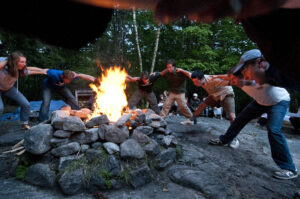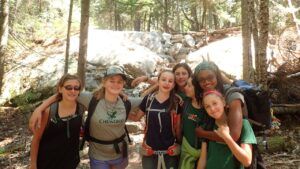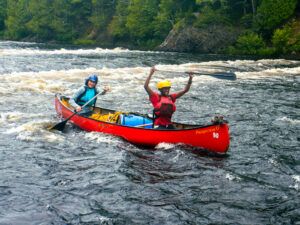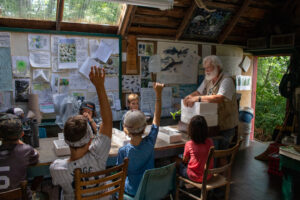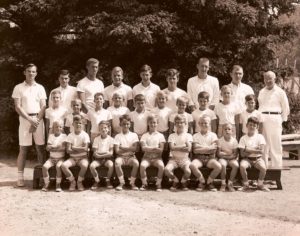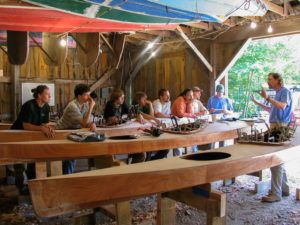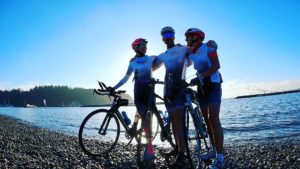The odd title of this piece is a take on John Ciardi’s classic book, How Does A Poem Mean? Ciardi was one of the great literary interpreters and word sluths of our day. To him every word “…is a feeling…involves the muscles…is a history…is a picture.”, that is, a dynamic “how”, not a static “what”. As Ciardi said, “the history tends to remain in them [i.e., words] as an immediate and intrinsic force.”
Would it surprise you then, that the Chewonki Camp Cheer might be more than it seems? All those strange words are actually from Abenaki, the language of the Wabenaki*, the First People of Maine, and they tell us something about how Wabenaki experienced this remarkable place on the coast of Maine.
THE CHEWONKI CAMP CHEER
Kenne-bec-bec1, Coec, Coec2!
Sag-a-da-hoc3, a Hock-o-mock4!
Wiscasset5 Chow, Nequasset6 Chaw,
Chew’em up quick, Chewonki7!
What? Chewonki!
What?! CHEWONKI!!
- Kennebec. The Kennebec River is the second longest in Maine and it drains about one-third the state. The original Abenaki was Kini (“long”) + beg∞ (“flat water”), and referred to the extensive stretch of easy paddling between Merrymeeting Bay (Abenaki, Meromini Beg∞ (“Wild Rice Flat Water, or Lake”) and what is now Augusta (or to the Wabenaki, Koosinok: “Above the tide”) Technically speaking, and to the geographically astute Wabenaki, the Kennebec River ended in Merrymeeting Bay (north of Bath), along with the other five rivers that flow into it (Androscoggin, Eastern, Cathance, Abadagasset, and Muddy), and the “river” downstream from there to the Gulf of Maine was (and is properly to be) called the Sagadahok (see, below), not the “Lower Kennebec” River.*
Wabenaki means ”The People of the Dawn Land”, and our local band of Wabenaki were the Wawenok (sometimes called the Sagadahoks) who inhabited the Maine coast from the Sagadahok to roughly the St. Georges River, and about 50 miles inland. The Wawenok were largely dispersed by 1800, with some descendants today in St. Francis, Quebec. Abenaki was not originally a written language. With European colonization, however, Abenaki phonemes were variously rendered in the Roman alphabet, along with special symbols for unusual sounds. To this day, the orthography has not been fully standardized.
- Coec . This looks like a nonsense word. Maybe so. But with a minor change in spelling to kow’ek, it looks strikingly similar to an abbreviated form of the Abenaki Kowa’sek , “White Pine place”. Of course, there’s no way to prove that it is, but Kow’ek—“Place of the White Pine”—is certainly most descriptive of our region in Maine. So, why not just accept this interpretation of “coec” in the camp cheer. And, there is an even more important consideration, for 80 years, until it succumbed to the ravages of time in 1998, the venerable, centuries-old, Sentinel White Pine presided over Campfire Circle as its tutelary spirit, embracing generations of Chewonki campers. It is this White Pine that is immortalized in our campfire song: “Neath The Pine Tree, Round the Camp Fire…” Surely then, Camp Chewonki itself is Kow’ek—The Place of the White Pine. Every Chewonki camper would do well to pay homage to the Sentinel White Pine by visiting its stump and commemorative plaque still in place at Campfire Circle.
- Sagadahok. (Note: Since “c” in Abenaki, as written today, is always soft and followed by “h”, “Sagadahoc” really should be spelled Sagadahok… Other variants include Sakadaguk and Sankderank). The word is Abenaki for any tidal river (really a narrow estuary) that issues directly into the open sea, as opposed to a bay (as does the Penobscot River, the Sheepscot River, and even our Montsweag Creek). Today, the name Sagadahok formally applies only to what folks here about mistakenly call the “Lower Kennebec River” (see, Kennebec, above). Thus, Sagadahoc (k) County, Maine, takes its name from THE Sagadahok, which runs through it.
- Hockomock.. On old maps it was spelled Hobbomocca, and attached geographically to Hobbomocca Point off Lower Hell’s Gate, where the Sasanoa River (named for a Wawenok sachem) joins Hockomock Bay. The original Abenaki was Hobomoko, literally “disaster”, “perdition”, or simply “Hell”. Anyone who’s tried to navigate the Hell,s Gates on the wrong tide knows exactly why!
- Wiscasset., our fair town. To the Wawenok it was Wichika’sek,, “Place where the river springs forth”, a description of the Sheepscot River (Pjespkoke, “River that divides into many channels”, at present-day Wiscasset. Incidentally, the Abenaki Wichi means “spring” and was applied to all springs, including the one formerly at, so-called “Witch” (originally Wichi!) Spring Hill, in West Bath, and thence to the local ice cream bar, popular with Chewonki folks. Like “Mt.” Katadin (=Mount Great Mountain), “Witch” Spring Hill (=Spring Spring Hill), is the ultimate geographic redundancy.
- Nequasset. The name of the lake in Woolwich, Maine, that serves as the municipal water supply for Bath, Wiscasset and surroundings. Nequasset. Is from the Abenaki, Nekwasebem(g?), “Pond”. Nequasset Lake ultimately drains into the Sagadahok through a short run, and still sustains a sizable run of river herring each spring. Prior to the town of Woolwich, the entire region thereabouts was called Nequasset.
- Chewonki.. Our fair camp. Despite the several popular interpretations (including, “Place of the Turning”, and “Where The Wild Geese Come”), Fanny Eckstorm argues persuasively (at least to my mind) that the word Chewonki is actuallyfrom the Abenaki, Che (“Big”) + adowakeag (“Ridge”). Elsewhere, such ridges were often called “horsebacks” or “hogbacks”. Given our place in Maine, would be too much poetic license to call Chewonki’s ridge a “mooseback”? Well then, we have it: Chewonki,, The Big Mooseback . And, apt it might have seemed to our Wawenok predecessors. The high ridge forming the spine of lower Chewonki Neck might have easily suggested to a receptive imagination the back of a recumbent moose. Just walk the trail up to blueberry Hill (the “moose’s” shoulders), and see if you don’t agree.
Offered to the Chewonki community by (“Doc”)Fred Cichocki. Interpretations based primarily on the following:
Chandler, E.J. 1997. Ancient Sagadahoc: A Narrative History. Conservatory of American Letters, Thomaston, ME. Eckstorm, F. 1941.. Indian Place Names of the Penobscot Valley and the Maine Coast. Maine Studies No. 55. University of Maine.
Hardy, K. 2009. Notes on a Lost Flute: A Field Guide to the Wabanaki. Down East Books.
Hardy, K. ? Search For the Wawenocks: Four guides to the Past (on line source)
Laurent, J. 1884. New Familiar Abenakis and English Dialogs.
Speck, F. G. 1928. Wawenock Myth Texts From Maine. 43rd Annual Report, Bureau of American Ethnology, Smithsonian Institution.
Penobscot-Abenaki Pronunciation and Spelling guide. www.native-languages.org/abna_guide.html
(2012, Last revised, Spring 2019.)
